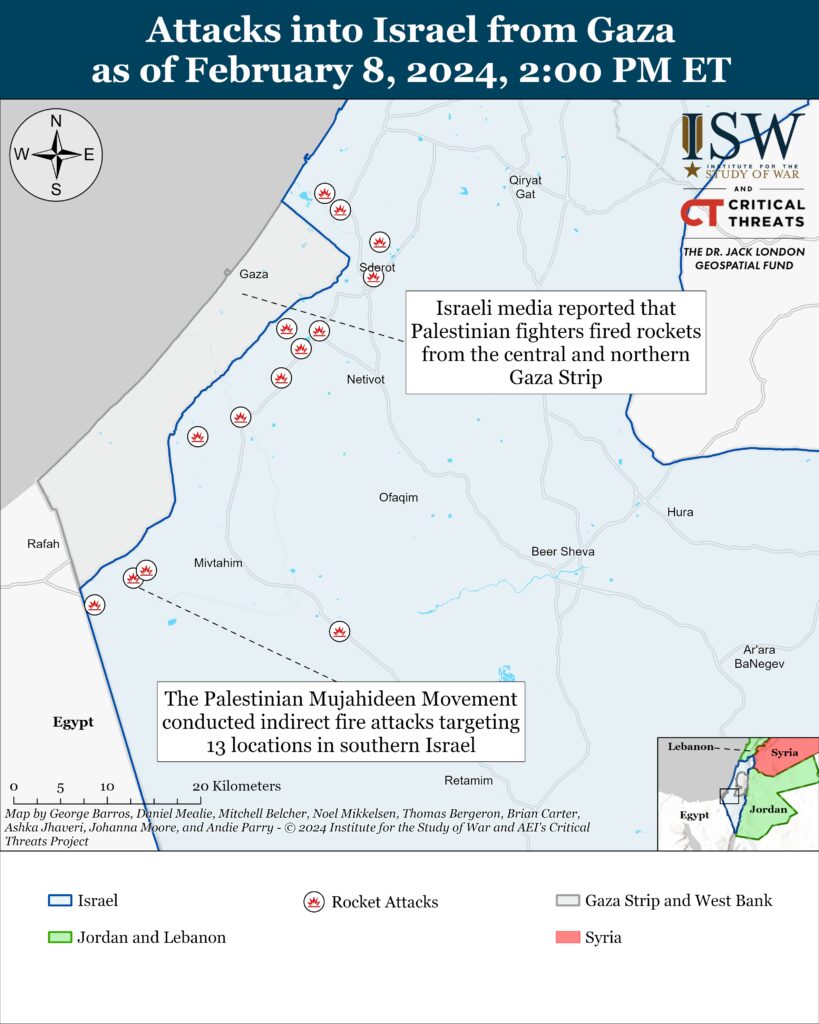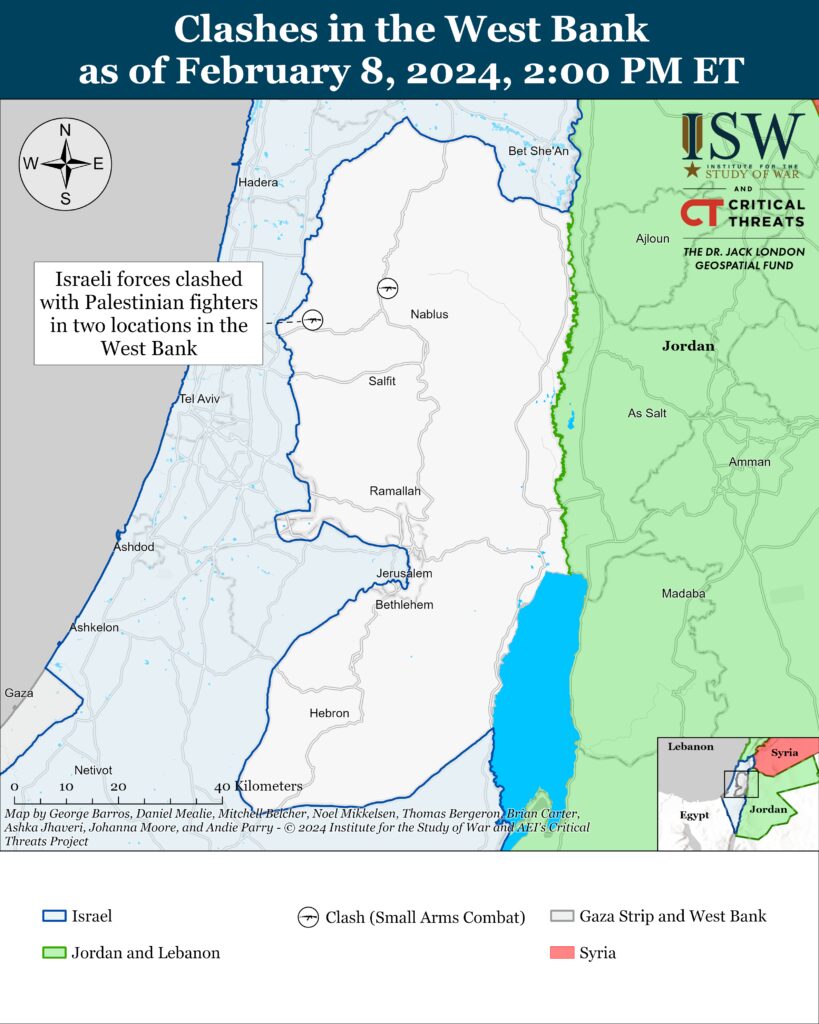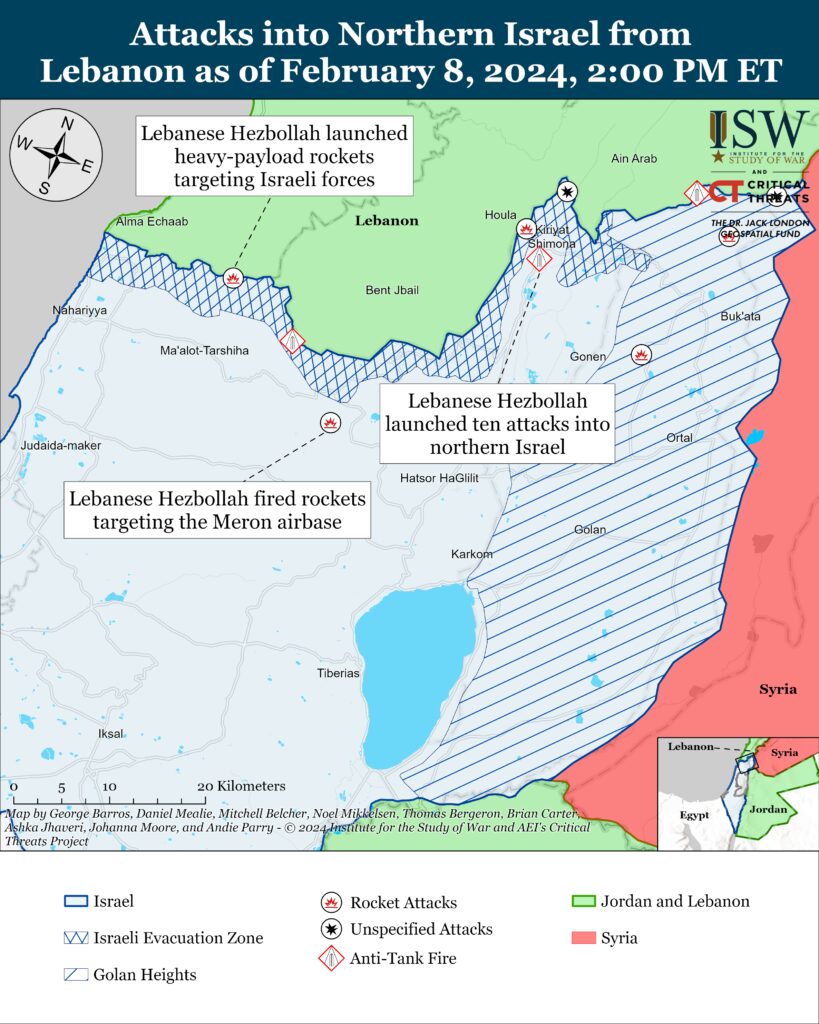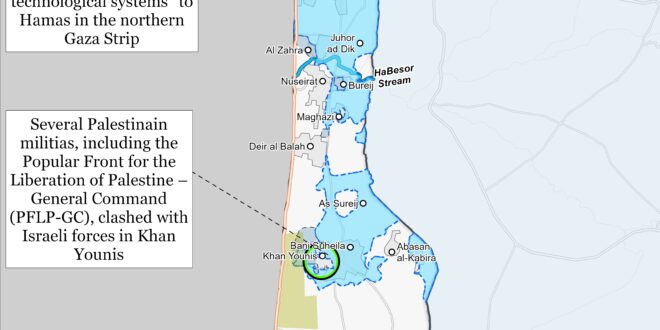- Northern Gaza Strip: Palestinian fighters are continuing to infiltrate previously cleared areas.
- Southern Gaza Strip: The Israel Defense Forces 98th Division continued to conduct clearing operations in Khan Younis.
- Political Negotiations: Israel reportedly proposed to the United States exiling the leader of Hamas in the Gaza Strip, Yahya Sinwar, in exchange for Hamas returning all hostages and an end to the Hamas government in the Gaza Strip.
- West Bank: Israeli forces clashed with Palestinian fighters in two locations.
- Southern Lebanon and Golan Heights: Iranian-backed militias, including Lebanese Hezbollah, conducted 10 attacks from southern Lebanon into northern Israel.
- Iraq: Iranian-backed Iraqi actors are continuing to exploit US military operations in Iraq to amplify pressure on the Mohammad Shia al Sudani administration to expel US forces from Iraq.
- Syria: An unspecified Iraqi militia group conducted a drone strike targeting US forces at the al Omar oil field in Deir ez Zor Province, according to regional and local Syrian outlets.
- Yemen: The United States conducted self-defense strikes targeting Houthi missile sites in Yemen.

Gaza Strip
Axis of Resistance campaign objectives:
Erode the will of the Israeli political establishment and public to launch and sustain a major ground operation into the Gaza Strip
Degrade IDF material and morale around the Gaza Strip.Palestinian fighters are continuing to infiltrate previously cleared areas in the northern Gaza Strip. The Israel Defense Forces (IDF) Unit 414 Intelligence Battalion (assigned to the 143rd Division) directed a drone strike on February 8 targeting a Palestinian militia squad that was attempting to “transfer technological systems” to Hamas in the northern Gaza Strip.[i] Unit 414 previously encountered Palestinian fighters that were attempting to establish a Hamas reconnaissance position in Beit Hanoun on February 6.[ii] CTP-ISW assessed on January 22 that Hamas and other Palestinian militias are likely in the early stages of reconstituting their military capabilities in the northern Gaza Strip.[iii]
The IDF 401st Brigade (assigned to the 162nd Division) killed 10 Palestinian fighters in several clashes in the northern Gaza Strip on February 8.[iv] Palestinian militias, including Hamas, claimed attacks targeting Israeli forces in Gaza City using small arms and rocket-propelled grenades (RPG).[v] A Palestinian activist reported clashes between Israeli forces and Palestinian fighters in several neighborhoods of western Gaza City, including Sheikh Ijlin and Tal al Hawa, on February 8.[vi]
The IDF 98th Division continued to conduct clearing operations in Khan Younis on February 8. The 35th Commando Brigade (assigned to the 98th Division) “increased attacks” in western Khan Younis, according to the IDF.[vii] Israeli forces clashed with Palestinian fighters, raided military facilities, and located weapons, including long-range rockets. Palestinian militias have been conducting a deliberate defense against Israeli ground operations in western Khan Younis since the IDF began operating there on January 22.[viii]
The IDF 35th Paratroopers Brigades (assigned to the 98th Division) and 84th Givati Brigade (assigned to the 162nd Division) killed over 20 Palestinian fighters during attacks in Khan Younis on February 8.[ix] Several militias aligned with Hamas in the war attacked Israeli forces in southern and western Khan Younis.[x] The Popular Front for the Liberation of Palestine–General Command (PFLP-GC) reported that its fighters clashed with Israeli forces in Khan Younis.[xi] The PFLP-GC is a Palestinian faction based primarily in Syria.[xii] The faction receives support from Iran and has cooperated with other elements of Iran’s “Axis of Resistance,” such as Lebanese Hezbollah and the Syrian regime.[xiii] CTP-ISW has not previously observed the PFLP-GC attacking the IDF in the Gaza Strip since the war began.
The IDF published on February 8 footage of a conversation with a detained commander in Hamas’ elite Nukhba unit.[xiv] The commander Muhammad Nasser Suleiman Abu Namer, who the IDF detained in Khan Younis, told Israeli Shin Bet officers that he and two other Hamas fighters “didn’t want to fight” and turned themselves over to Israeli forces approaching them in tunnels in Khan Younis. Namer urged other Palestinian fighters to surrender in the footage. Namer has been a member of Hamas since 2009.[xv]


Israel reportedly proposed to the United States exiling the leader of Hamas in the Gaza Strip Yahya Sinwar in exchange for Hamas returning all hostages and an end to the Hamas government in the Gaza Strip, according to six unspecified Israeli officials.[xvi] A senior adviser to the Israeli government said that the idea of exiling Sinwar and other Hamas leaders has been “on the table” since November 2023, referring to the ongoing negotiations between Israel and Hamas. Israeli officials have vowed to kill Sinwar and other planners of the October 7, 2023, attack.[xvii] Sinwar founded and led Hamas’ internal security apparatus and is responsible for the deaths of many Israelis and Palestinians in that role.[xviii] Israel proposed exiling Sinwar as part of several suggestions sent to the United States.[xix] These suggestions included replacing Hamas with “hand-picked” civilian leaders and reforming the education system in the Gaza Strip.
The Palestinian Mujahideen Movement fired rockets from the Gaza Strip targeting 13 locations in southern Israel, as the group commemorated the anniversary of its launch on February 8.[xx] The group is a Palestinian faction aligned with Hamas and has expressed close ties with Iran.[xxi] The group announced on February 8 that Israeli airstrikes killed five of its military council members.[xxii] Israeli Army Radio reported that Palestinian fighters fired the rockets from the northern and central Gaza Strip.[xxiii] The launches demonstrate that Palestinian militias in the northern and central Gaza Strip retain some ability to fire rockets into Israel, despite Israeli operations. The Democratic Front for the Liberation of Palestine, which is a leftist Palestinian militia aligned with Hamas in the war, reported that its fighters fired a rocket salvo targeting a town in southern Israel bringing the total number of targeted locations on February 8 to 14.[xxiv] Palestinian militias have not claimed responsibility for this many rocket attacks since December 4, 2023.[xxv]

Recorded reports of attacks; CTP-ISW cannot independently verify impact.
West Bank
Axis of Resistance campaign objectives:
Draw IDF assets and resources toward the West Bank and fix them thereIsraeli forces clashed with Palestinian fighters in two locations across the West Bank on February 8.[xxvi]

This map is not an exhaustive depiction of clashes and demonstrations in the West Bank.
Southern Lebanon and Golan Heights
Axis of Resistance campaign objectives:
Draw IDF assets and resources toward northern Israel and fix them there
Set conditions for successive campaigns into northern IsraelIranian-backed militias, including Lebanese Hezbollah, conducted 10 attacks from southern Lebanon into northern Israel on February 8.[xxvii] Hezbollah launched rockets at an IDF base on Mount Meron that hosts air traffic control, radar, surveillance, communications, and jamming facilities.[xxviii] Hezbollah said that it conducted the rocket attack ”in retaliation” for an Israeli strike on a car in Nabatiyeh, southern Lebanon.[xxix] Hezbollah has previously targeted the Meron Base in response to Israeli strikes in Lebanon and not as part of its regular attack campaign along the border.[xxx] Hezbollah fighters also targeted the headquarters of the IDF 769th Eastern Brigade (assigned to the 91st Galilee Division) in Kiryat Shmona, seriously injuring one IDF soldier.[xxxi]
The IDF Northern Command Commander Major General Uri Gordin visited Israeli forces in training on February 8.[xxxii] The IDF 36th Division, which operated in the northern Gaza Strip in 2023, is part of the force training to increase ”readiness for the operational plans against the northern enemy in defense and attack.”[xxxiii] The IDF began this week a series of intensive platoon- and battalion-level training focused on combat in densely populated neighborhoods in winter conditions.[xxxiv]

Recorded reports of attacks; CTP-ISW cannot independently verify impact.
Iran and Axis of Resistance
Axis of Resistance campaign objectives:
Demonstrate the capability and willingness of Iran and the Axis of Resistance to escalate against the United States and Israel on multiple fronts
Set conditions to fight a regional war on multiple frontsIranian-backed Iraqi actors are continuing to exploit US military operations in Iraq to amplify pressure on the Mohammad Shia al Sudani administration to expel US forces from Iraq. The United States killed on February 7 a senior Kataib Hezbollah commander who planned and participated in attacks targeting US forces in the region.[xxxv] The Iraqi Parliament announced that it will convene on February 10 to discuss “attacks on Iraqi sovereignty.”[xxxvi] An Iranian-backed Badr Organization member stated that Parliament will meet to draft a law requiring the Iraqi federal government to implement the January 2020 non-binding parliamentary resolution to expel “all foreign forces” from Iraq “by the end of next June.”[xxxvii] It is unclear whether this parliamentarian was referring to June 2024 or 2025. The Iraqi Parliament passed this resolution after the United States killed IRGC Quds Force Commander Major General Qassem Soleimani in January 2020. Acting Parliament Speaker Mohsen al Mandalawi recently expressed support for implementing the January 2020 non-binding resolution on February 4.[xxxviii] Mandalawi is affiliated with the Shia Coordination Framework, which is a coalition of prominent Iraqi Shia parties, including some closely tied to Iran. Another Badr Organization member stated that Mandalawi agreed to put a January 2024 draft law to remove “all foreign troops” from Iraq on Parliament’s agenda[xxxix] This draft law differs from the January 2020 resolution in that it requires Prime Minister Sudani to author a report detailing how his administration would end the US presence in Iraq.[xl]
Iranian-backed Iraqi actors also criticized how the Sudani administration is approaching negotiations with the United States over this issue. The United States and Iraqi federal government announced in late January 2024 the beginning of “working group meetings” to evaluate the status of the US-led Global Coalition’s mission to defeat ISIS.[xli] The next such meeting will take place on February 11.[xlii] Politico previously reported that senior Iraqi advisors to Sudani told the US State Department that Sudani does not seek the expulsion of US forces.[xliii] The head of Iranian-backed Iraqi militia Kataib Hezbollah’s parliamentary bloc stated that negotiating with the United States after its February 7 strike “will represent an insult to Iraq.”[xliv] A former commander of Kataib Hezbollah similarly described negotiations with the United States as “shameful and flawed.”[xlv]
Iranian-backed Iraqi militias are trying to rally Iraqi citizens against the United States. Harakat Hezbollah al Nujaba released a statement on February 8 calling on the Iraqi people to help the Popular Mobilization Forces (PMF) and “men of resistance” confront the United States.[xlvi] Kataib Sayyid al Shuhada similarly called on Iraqis to “join” and “rally around” Iraqi militias that are “resisting” the United States on February 8.[xlvii] These militia calls follow a large demonstration against the United States in front of the US Embassy in Baghdad immediately after the US strike that killed a senior Kataib Hezbollah commander on January 7.[xlviii]
An American analyst provided new details about the senior Kataib Hezbollah official, named Wissam Mohammad Saber al Saedi (Abu Baqr al Saedi), whom the United States killed in a precision strike in Baghdad on February 7.[xlix] Saedi headed the PMF Central Security Directorate in Rusafa and suppressed protesters during the popular Tishreen protest movement that began in October 2019.[l] The Tishreen movement erupted in response to high unemployment, poor government service provision, and rampant corruption within the government.[li] 600 protesters died during the first six months of the protests.[lii]
Saedi was involved in the February 2022 Alwiya Waad al Haq (the Righteous Promise Brigades) attacks targeting “vital facilities” in the United Arab Emirates.[liii] Alwiya Waad al Haq threatened to attack US forces in Kuwait and the United Arab Emirates at the beginning of the Israel-Hamas war.[liv] CTP-ISW previously assessed that this group was likely a front for Kataib Hezbollah.[lv]
Saedi was additionally involved in Kataib Hezbollah’s operations in Syria.[lvi] An Axis of Resistance-affiliated Iraqi Telegram channel claimed on February 7 that Saedi conducted “relief work” in Syria following the February 2023 earthquake.[lvii] CTP-ISW previously assessed that Iran and its proxy and partner militias exploited the February 2023 earthquake to move advanced weaponry and military equipment into Syria.[lviii]
The Syrian Democratic Forces (SDF) commander said on February 8 that unspecified US officials told the SDF that US forces would not withdraw from Syria.[lix] SDF Commander Mazloum Abdi said that a US withdrawal from Iraq could cause a US withdrawal from Syria.[lx] The United States and Iraqi federal government announced on January 25 that they will soon start negotiations to discuss Iraq’s current security arrangement with US-led coalition forces.[lxi] These negotiations could precipitate the withdrawal of US forces from Iraq and, in turn, a scaling back of US forces in Syria.[lxii] The US force presence in Syria relies on US logistical networks in Iraq. A US withdrawal from Iraq and Syria would likely create space for ISIS to quickly resurge, as CTP-ISW has assessed.[lxiii]
An unspecified Iraqi militia group conducted a drone strike targeting US forces at the al Omar oil field in Deir ez Zor Province, Syria, on February 8, according to regional and local Syrian outlets.[lxiv]
The United States conducted self-defense strikes targeting Houthi missile sites in Yemen on February 7.[lxv] US forces struck two Houthi anti-ship cruise missiles and a land attack cruise missile. US CENTCOM said that the Houthi missiles were prepared to launch and posed an ”imminent” threat to US ships and merchant vessels in the Red Sea. Houthi and other regional sources reported that US forces targeted missile sites in al Salif and Ras Issa in Hudaydah Governorate and al Qutaynat in Sadaa Governorate.[lxvi] Houthi spokesperson Mohammed Abdul Salem said that the strikes will not deter the Houthis from conducting further attacks.[lxvii]

Iranian Supreme Leader Ali Khamenei discussed the Israel-Hamas war in a meeting with Iranian regime officials and representatives from other Muslim countries on February 7.[lxviii] Khamenei claimed that the war illustrates that the current world order is “invalid and unsustainable and will disappear.” Khamenei claimed that the withdrawal of pro-Western forces “from this issue” is the solution to the war. Khamenei reiterated his months-long call for all countries to sever economic and political relations with Israel.
 Eurasia Press & News
Eurasia Press & News



